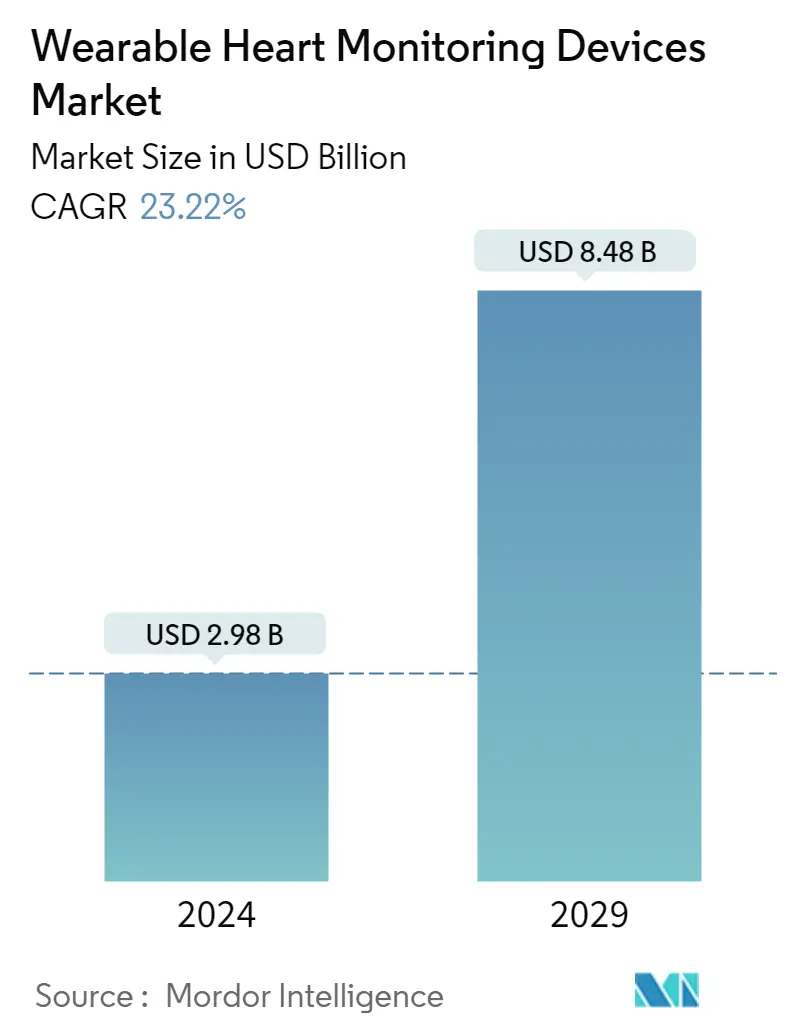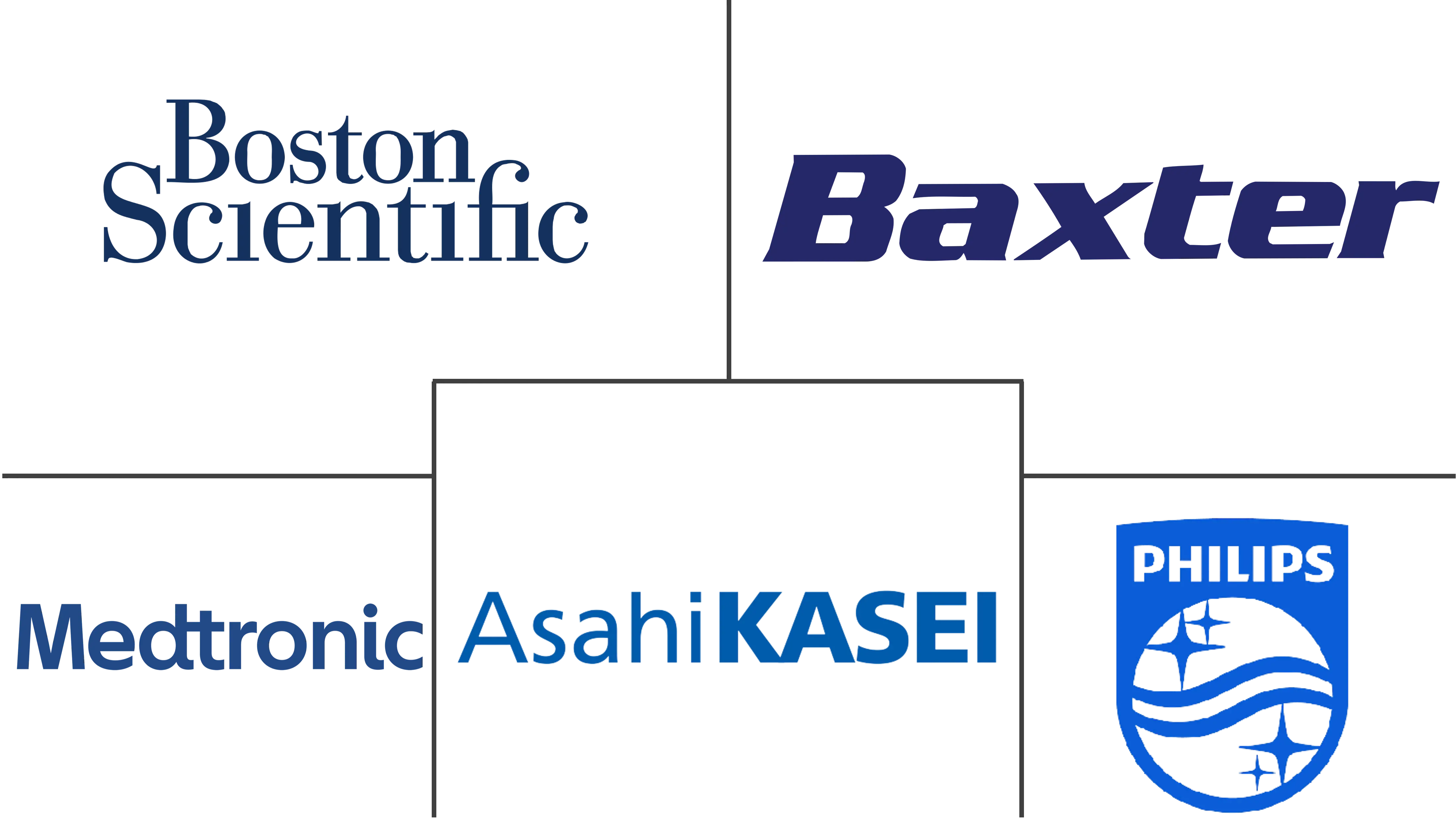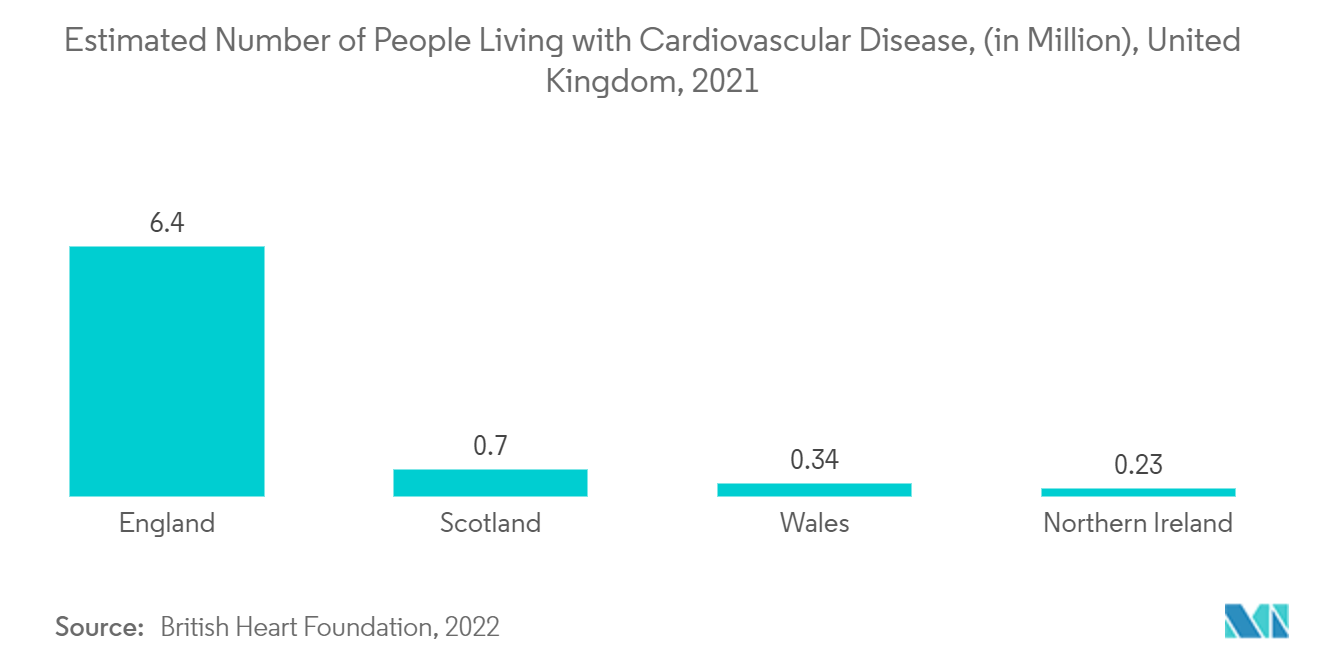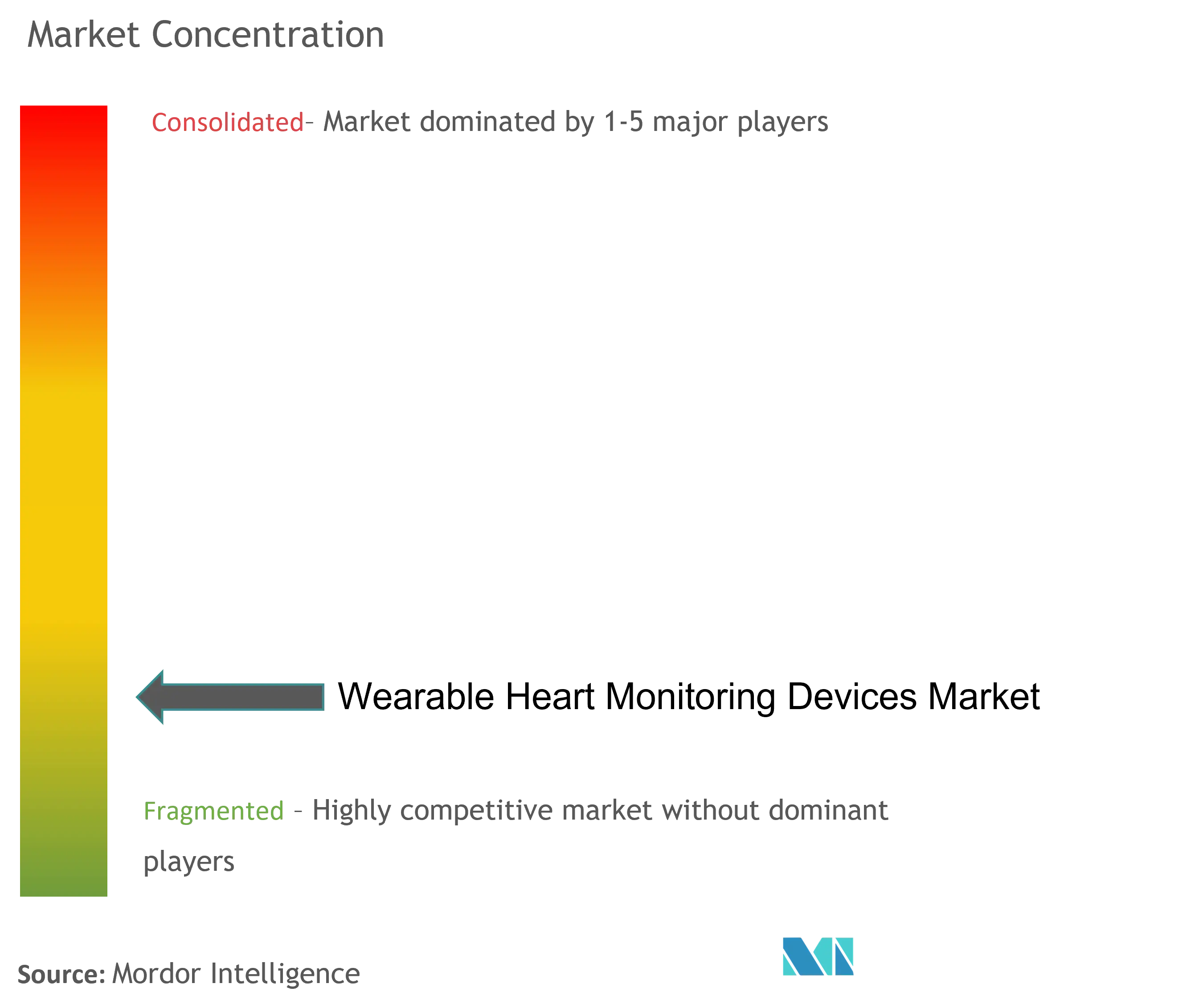Wearable Heart Monitoring Devices Market Size

| Study Period | 2019 - 2029 |
| Market Size (2024) | USD 2.98 Billion |
| Market Size (2029) | USD 8.48 Billion |
| CAGR (2024 - 2029) | 23.22 % |
| Fastest Growing Market | Asia-Pacific |
| Largest Market | North America |
Major Players
*Disclaimer: Major Players sorted in no particular order |
Wearable Heart Monitoring Devices Market Analysis
The Wearable Heart Monitoring Devices Market size is estimated at USD 2.98 billion in 2024, and is expected to reach USD 8.48 billion by 2029, growing at a CAGR of 23.22% during the forecast period (2024-2029).
During the COVID-19 pandemic, coronavirus-infected patients were more likely to develop heart problems and vice-versa, which increased the risk. This was attributed to the rising demand for wearable heart monitoring devices, as the real-time monitoring of cardiovascular disease effectively reduced COVID-19 mortality rates. For instance, as per the article published in February 2021 in JMIR publications, wearable devices can identify COVID-19 cases earlier than traditional diagnostic methods and can help track and improve the management of the disease. Significant changes in heart rate variability (HRV) were seen before the identification of COVID-19 by nasal PCR, suggesting its predictive capacity to diagnose COVID-19 infection. However, for some patients, heart problems persisted long after the impact of COVID-19 infection. For instance, as per the article published in February 2022 in Nature journal, people who had recovered from COVID-19 showed stark increases in cardiovascular problems over the year after infection. Therefore, the awareness of wearable technology among cardiac patients is constantly rising, and the wearable heart monitoring devices market will see rapid expansion in the near future.
Certain factors that are driving the market growth include the increasing rate of heart failure, rising awareness of wearables-based cardiac monitoring, and technological advancements in wearable devices. The CDC update published in October 2022 stated that coronary heart disease is the most common type of heart disease, and around 20.1 million adults aged 20 and older have coronary artery disease (approximately 7.2%). Thus, the high burden of coronary artery disease is driving the growth of the market. Further, as per the 2022 Spotlight on Heart Failure report, more than 100,000 Canadians are diagnosed with heart failure each year. As per the same source, Heart failure is likely to cost Canada more than USD 2.8 billion a year. Therefore, the rising cases of heart failure and increasing healthcare cost demands heart monitoring devices based on wearable technology to reduce the cost and improves heart monitoring.
In addition, in January 2021, Boston Scientific acquired Preventice Solutions for USD 925 million. Preventice Solutions is a manufacturer of several wearable cardiac sensors (BodyGuardian) used for remote patient monitoring. These devices are developed for adult as well as pediatric patients. Therefore, from this acquisition, Boston Scientific expanded its business segment of core cardiac rhythm management and electrophysiology which in turn strengthened its position in this attractive market.
Moreover, in February 2021, RhythMedix launched the newest-generation wearable ECG monitor named 'RhythmStar'. This device has built-in cellular connectivity which can collect ECG recordings by itself and send data wirelessly to physicians without the use of a phone. This simplified and time-saving approach may entice more customers and raise their market potential. Thus, the rise in the adoption of advanced technology in wearable devices comprises benefits that help patients and physicians to manage heart problems in a better way, thereby contributing to market growth.
Thus, due to the rise in cardiac complications, and the increase in heart-monitoring wearable product launches, the wearable heart-monitoring devices market is anticipated to witness growth over the forecast period. However, privacy & security issues of wearable devices and stringent rules and regulatory policies are major factors hindering the wearable heart monitoring devices market's growth.
Wearable Heart Monitoring Devices Market Trends
This section covers the major market trends shaping the Wearable Heart Monitoring Devices Market according to our research experts:
The Optical Technology-based Product is Projected to Have a Notable Growth Rate in the Wearable Heart Monitoring Devices Market Over the Forecast Period
The optical technology-based product segment is anticipated to register a significant growth rate during the forecast period owing to the factors such as the rise in the prevalence of cardiovascular diseases (CVDs), the growing geriatric population, and the rising product approvals This optical technology-based product is based on a method called photoplethysmography (PPG). It measures heart rate by shining light into the skin and measuring the amount of light that is scattered by blood flow. These days, wearable devices based on optical technology are gaining wide interest for continuous monitoring of the heart rate. Attributable to its uncomplicated features, available direct-to-consumer, reduce direct contact with clinical staff, and is inexpensive as compared to electric pulse-based products.
Further, according to the Government of the UK, Office of Health Improvement & Disparities, in 2020-21 the admission rate for chronic heart disease in NHS Barking and Dagenham CCG was 427.9 for every 100,000 people in the population (580 admissions). This was significantly higher than the England rate (368 per 100,000). Thus, the rise in cardiovascular complications increases the demand for heart monitoring thereby driving the segment growth over the forecast period. Most CVDs can be inhibited by real-time monitoring of heart rate, which plays a vital role in reducing the mortality and cost of treatment. For instance, data published by American Heart Association (AHA) in November 2021 found that the Fitbit PPG detections identified atrial fibrillation (AF) events 98% of the time, as confirmed by ECG patch monitors. Thus, the rising efficiency of the PPG algorithm is expected to increase the demand for optical technology-based products in the coming years, thereby contributing to market growth.
In addition, numerous market players are focused on the execution of strategic initiatives, thereby contributing to the growth of the wearable heart monitoring devices market. For instance, in April 2022, Google-owned Fitbit received product approval from the FDA for a new photoplethysmography (PPG) algorithm named 'AFib' to identify AF. This algorithm is likely to power a new irregular heart rhythm notification feature on the Fitbit device. Therefore, due to the advancements offered by the key players in optical technology-based products for wearable heart monitoring devices, this market segment is expected to witness significant growth during the forecast period.
Hence, due to the increase in cardiac diseases, and the surge in optical technology-based cardiac monitoring wearable product launches, the studied segment in the market is anticipated to witness growth over the forecast period.

North America is Likely to Hold a Significant Share in the Market Over the Forecast Period
North America is likely to hold a significant share of the wearable heart monitoring devices market. This is due to factors such as the rising incidences of CVDs and the presence of major market players and their strategic initiatives. For instance, as per the CARES 2021 annual report, 62.5% of males were reported with out-of-hospital cardiac arrest (OHCA) in the United States. As per the same source, 97.6% of adults and 2.4% of children experienced OHCA in 2021 in the United States. Thus, as the number of cardiac complications increases, the demand for wearable heart monitoring devices rises and drives the market growth over the forecast period.
Due to government initiatives and the growing nature of the wearable heart monitoring device market, the major players have shifted their focus in this industry and engaged in the implementation of strategic initiatives. For instance, in March 2022, Biotricity Inc., a medical diagnostic and consumer healthcare technology company, launched its FDA-cleared, wireless wearable cardiac monitoring device, Biotres. The product was available for physicians, medical offices, hospitals, and individual use since late-February 2022.
Furthermore, in August 2022, Samsung Canada launched the Galaxy Watch5 and Galaxy Watch5 Pro equipped with a unique BioActive Sensor technology from Samsung that drives the next era of digital health. It comes with Samsung BioActive Sensor (Optical Heart Rate + Electrical Heart Signal + Bioelectrical Impedance Analysis), Temperature Sensor, Accelerometer, Barometer, Gyro Sensor, Geomagnetic Sensor, and Light Sensor.
Hence, due to the increase in cardiac diseases, and the surge in cardiac monitoring wearable product launches, North America is anticipated to witness significant growth over the forecast period.

Wearable Heart Monitoring Devices Industry Overview
The wearable heart monitoring devices market is highly fragmented and consists of several major players. In terms of market share, a few of the major players are currently dominating the market. Some of the companies which are currently dominating the market are Medtronic plc, iRhythm Technologies, Inc., Baxter, Vital Connect, Inc., Asahi Kasei Corporation (ZOLL Medical Corporation), Koninklijke Philips N.V. (BioTelemetry, Inc.), Hemodynamics Company LLC, ACS Diagnostics, Inc., General Electric Company (GE Healthcare, Inc.), Boston Scientific (Preventice Solutions, Inc.), Qardio, Inc., Heartbit Holdings Plc.
Wearable Heart Monitoring Devices Market Leaders
-
Medtronic plc
-
Koninklijke Philips N.V. (BioTelemetry, Inc.)
-
Boston Scientific (Preventice Solutions, Inc.)
-
Asahi Kasei Corporation (ZOLL Medical Corporation)
-
Baxter
*Disclaimer: Major Players sorted in no particular order

Wearable Heart Monitoring Devices Market News
- In December 2022, researchers at the University of Missouri College of Engineering designed a breathable new heart health wearable with antimicrobial properties using a USD 2.6 million grant from the National Institute of Health.
- In March 2022, Amrita University, India, launched a wearable health monitoring device for home use. Amrita Spandanam is a wearable device that uses a finger clip to measure six body parameters: blood glucose, blood pressure, heart rate, blood oxygen, respiratory rate, and 6-lead ECG.
Wearable Heart Monitoring Devices Market Report - Table of Contents
1. INTRODUCTION
- 1.1 Study Assumptions & Market Defination
- 1.2 Scope of the Study
2. RESEARCH METHODOLOGY
3. EXECUTIVE SUMMARY
4. MARKET DYNAMICS
- 4.1 Market Overview
-
4.2 Market Drivers
- 4.2.1 Increasing Rate of Heart Failure
- 4.2.2 Rising Awareness of Wearables-based Cardiac Monitoring
- 4.2.3 Technological advancements in Wearable Devices
-
4.3 Market Restraints
- 4.3.1 Privacy and Security Issue of Wearable Devices
- 4.3.2 Stringent Rules & Regulatory Policy
-
4.4 Porter's Five Forces Analysis
- 4.4.1 Threat of New Entrants
- 4.4.2 Bargaining Power of Buyers/Consumers
- 4.4.3 Bargaining Power of Suppliers
- 4.4.4 Threat of Substitute Products
- 4.4.5 Intensity of Competitive Rivalry
5. MARKET SEGMENTATION (Market Size by Value - USD million)
-
5.1 By Product
- 5.1.1 Electric Pulse-based Product
- 5.1.2 Optical Technology-based Product
-
5.2 By Device Type
- 5.2.1 Diagnostic & Monitoring Devices
- 5.2.2 Therapeutic Devices
-
5.3 By Application
- 5.3.1 Sports & Fitness
- 5.3.2 Remote Patient Monitoring
- 5.3.3 Home Healthcare
-
5.4 Geography
- 5.4.1 North America
- 5.4.1.1 United States
- 5.4.1.2 Canada
- 5.4.1.3 Mexico
- 5.4.2 Europe
- 5.4.2.1 Germany
- 5.4.2.2 United Kingdom
- 5.4.2.3 France
- 5.4.2.4 Italy
- 5.4.2.5 Spain
- 5.4.2.6 Rest of Europe
- 5.4.3 Asia-Pacific
- 5.4.3.1 China
- 5.4.3.2 Japan
- 5.4.3.3 India
- 5.4.3.4 Australia
- 5.4.3.5 South Korea
- 5.4.3.6 Rest of Asia-Pacific
- 5.4.4 Middle East and Africa
- 5.4.4.1 GCC
- 5.4.4.2 South Africa
- 5.4.4.3 Rest of Middle East and Africa
- 5.4.5 South America
- 5.4.5.1 Brazil
- 5.4.5.2 Argentina
- 5.4.5.3 Rest of South America
6. COMPETITIVE LANDSCAPE
-
6.1 Company Profiles
- 6.1.1 Medtronic plc
- 6.1.2 Koninklijke Philips N.V. (BioTelemetry, Inc.)
- 6.1.3 Boston Scientific (Preventice Solutions, Inc.)
- 6.1.4 Asahi Kasei Corporation (ZOLL Medical Corporation)
- 6.1.5 Baxter
- 6.1.6 iRhythm Technologies, Inc.
- 6.1.7 ACS Diagnostics, Inc.
- 6.1.8 General Electric Company (GE Healthcare, Inc.)
- 6.1.9 Hemodynamics Company LLC
- 6.1.10 Heartbit Holdings Plc.
- 6.1.11 Qardio, Inc.
- 6.1.12 Vital Connect, Inc.
- *List Not Exhaustive
7. MARKET OPPORTUNITIES AND FUTURE TRENDS
** Subject To AvailablityWearable Heart Monitoring Devices Industry Segmentation
As per the scope of this report, wearable heart monitoring devices are usually worn on the chest or wrist. These devices contain smart sensors that can record both heart rhythm and heart rate, as well as can connect to mobile applications for data reporting. The Wearable Heart Monitoring Devices Market is Segmented by Product (Electric Pulse-based Product and Optical Technology-based Product), Device Type (Diagnostic & Monitoring Devices and Therapeutic Devices), Application (Sports & Fitness, Remote Patient Monitoring, and Home Healthcare), and Geography (North America, Europe, Asia-Pacific, Middle East and Africa, and South America). The market report also covers the estimated market sizes and trends for 17 different countries across major regions, globally. The report offers the value (in USD million) for the above segments.
| By Product | Electric Pulse-based Product | |
| Optical Technology-based Product | ||
| By Device Type | Diagnostic & Monitoring Devices | |
| Therapeutic Devices | ||
| By Application | Sports & Fitness | |
| Remote Patient Monitoring | ||
| Home Healthcare | ||
| Geography | North America | United States |
| Canada | ||
| Mexico | ||
| Geography | Europe | Germany |
| United Kingdom | ||
| France | ||
| Italy | ||
| Spain | ||
| Rest of Europe | ||
| Geography | Asia-Pacific | China |
| Japan | ||
| India | ||
| Australia | ||
| South Korea | ||
| Rest of Asia-Pacific | ||
| Geography | Middle East and Africa | GCC |
| South Africa | ||
| Rest of Middle East and Africa | ||
| Geography | South America | Brazil |
| Argentina | ||
| Rest of South America |
Wearable Heart Monitoring Devices Market Research FAQs
How big is the Wearable Heart Monitoring Devices Market?
The Wearable Heart Monitoring Devices Market size is expected to reach USD 2.98 billion in 2024 and grow at a CAGR of 23.22% to reach USD 8.48 billion by 2029.
What is the current Wearable Heart Monitoring Devices Market size?
In 2024, the Wearable Heart Monitoring Devices Market size is expected to reach USD 2.98 billion.
Who are the key players in Wearable Heart Monitoring Devices Market?
Medtronic plc, Koninklijke Philips N.V. (BioTelemetry, Inc.), Boston Scientific (Preventice Solutions, Inc.), Asahi Kasei Corporation (ZOLL Medical Corporation) and Baxter are the major companies operating in the Wearable Heart Monitoring Devices Market.
Which is the fastest growing region in Wearable Heart Monitoring Devices Market?
Asia-Pacific is estimated to grow at the highest CAGR over the forecast period (2024-2029).
Which region has the biggest share in Wearable Heart Monitoring Devices Market?
In 2024, the North America accounts for the largest market share in Wearable Heart Monitoring Devices Market.
What years does this Wearable Heart Monitoring Devices Market cover, and what was the market size in 2023?
In 2023, the Wearable Heart Monitoring Devices Market size was estimated at USD 2.42 billion. The report covers the Wearable Heart Monitoring Devices Market historical market size for years: 2019, 2020, 2021, 2022 and 2023. The report also forecasts the Wearable Heart Monitoring Devices Market size for years: 2024, 2025, 2026, 2027, 2028 and 2029.
Wearable Heart Monitoring Device Industry Report
Statistics for the 2023 Wearable Heart Monitoring Device market share, size and revenue growth rate, created by Mordor Intelligence™ Industry Reports. Wearable Heart Monitoring Device analysis includes a market forecast outlook to 2029 and historical overview. Get a sample of this industry analysis as a free report PDF download.



